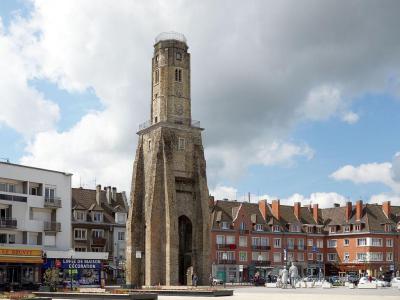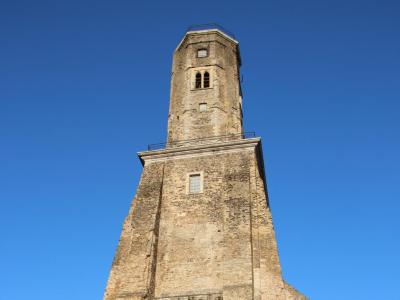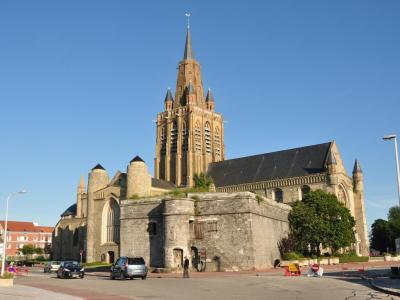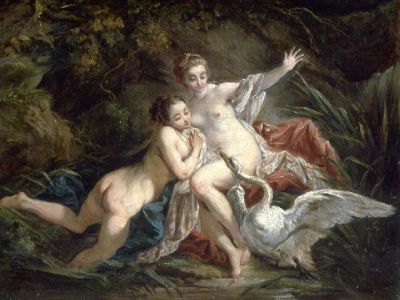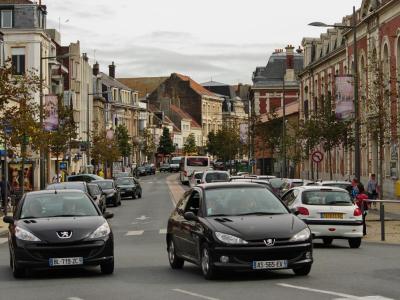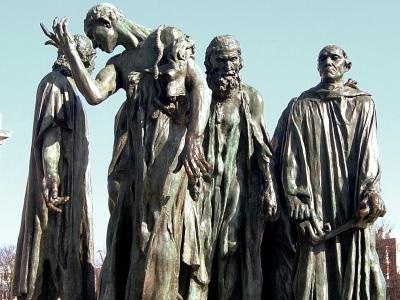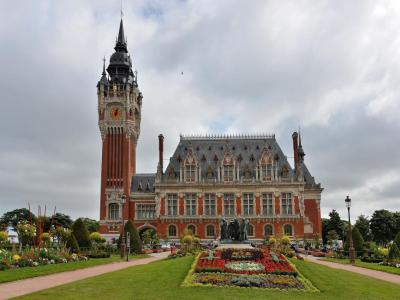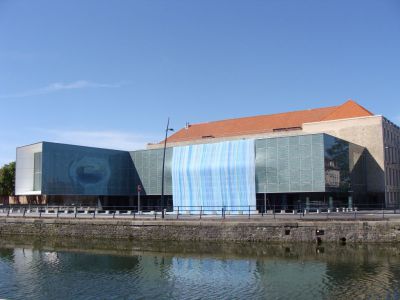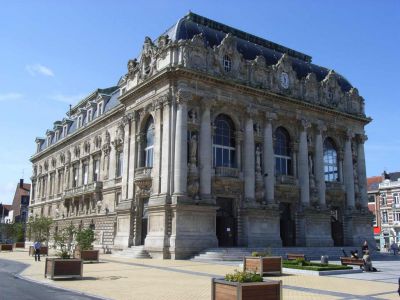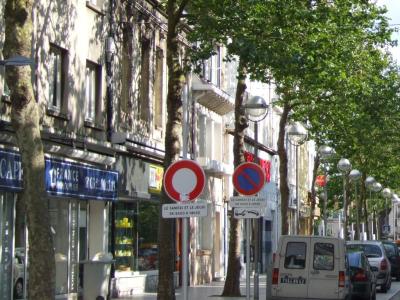Calais Introduction Walking Tour (Self Guided), Calais
Calais, a French port city, strategically overlooks the Strait of Dover at the English Channel's narrowest point, merely 34 km (21 miles). On a sunny day, one can clearly see the White Cliffs of Dover on the English side. A major ferry port between France and England, Calais also has been connected directly to the UK by rail, through the Channel Tunnel, since 1994.
The name Calais, tracing back to the 12th century, stems from 'Calesium,' related to the Latin 'Caletum.' The latter, in turn, originated from 'Caletes,' a Gallic tribe, whose name translates as "the hard ones," reflecting their resilient nature.
Historically, Calais's location has made it a key port and trading hub with England since the Middle Ages. Captured by Edward III of England in 1347 and formally assigned to English control in 1360, Calais thrived as a center for wool production, becoming vitally important for trades in tin, lead, lace, and wool, and was described as the "brightest jewel in the English crown." It remained under English rule until 1558 when it was recaptured by France. World War II saw Calais heavily bombarded and occupied by German forces.
Today, Calais attracts over 10 million visitors annually, continuing its legacy as a critical cross-channel conduit and cultural landmark. The heart of Calais beats strongest in its Old Town, Calais-Nord, situated on an artificial island surrounded by canals and harbors.
Central to this historic area is the Arms Square, which is dominated by the 13th-century watchtower, a testament to Calais’s medieval heritage.
A short stroll from the square leads you to the Notre-Dame church, a unique example of English perpendicular architectural style in France.
The Royal Street provides a picturesque path through the city, lined with shops and quaint cafes, leading to another monumental site, 'The Burghers of Calais' sculpture by Auguste Rodin.
Calais's administrative elegance is captured in its Flemish-Renaissance-style Town Hall, a UNESCO World Heritage Site, featuring an early 20th-century belfry. Meanwhile, fashion and textile enthusiasts will find intriguing the Museum of Lace and Fashion.
For those drawn to a city where history and modernity converge, Calais offers a mosaic of experiences. We hereby invite you to explore the streets, museums, and markets of this historic city, and discover its enduring allure. Plan your visit now and enjoy a charming escape with the help of this self-guided walk.
The name Calais, tracing back to the 12th century, stems from 'Calesium,' related to the Latin 'Caletum.' The latter, in turn, originated from 'Caletes,' a Gallic tribe, whose name translates as "the hard ones," reflecting their resilient nature.
Historically, Calais's location has made it a key port and trading hub with England since the Middle Ages. Captured by Edward III of England in 1347 and formally assigned to English control in 1360, Calais thrived as a center for wool production, becoming vitally important for trades in tin, lead, lace, and wool, and was described as the "brightest jewel in the English crown." It remained under English rule until 1558 when it was recaptured by France. World War II saw Calais heavily bombarded and occupied by German forces.
Today, Calais attracts over 10 million visitors annually, continuing its legacy as a critical cross-channel conduit and cultural landmark. The heart of Calais beats strongest in its Old Town, Calais-Nord, situated on an artificial island surrounded by canals and harbors.
Central to this historic area is the Arms Square, which is dominated by the 13th-century watchtower, a testament to Calais’s medieval heritage.
A short stroll from the square leads you to the Notre-Dame church, a unique example of English perpendicular architectural style in France.
The Royal Street provides a picturesque path through the city, lined with shops and quaint cafes, leading to another monumental site, 'The Burghers of Calais' sculpture by Auguste Rodin.
Calais's administrative elegance is captured in its Flemish-Renaissance-style Town Hall, a UNESCO World Heritage Site, featuring an early 20th-century belfry. Meanwhile, fashion and textile enthusiasts will find intriguing the Museum of Lace and Fashion.
For those drawn to a city where history and modernity converge, Calais offers a mosaic of experiences. We hereby invite you to explore the streets, museums, and markets of this historic city, and discover its enduring allure. Plan your visit now and enjoy a charming escape with the help of this self-guided walk.
How it works: Download the app "GPSmyCity: Walks in 1K+ Cities" from Apple App Store or Google Play Store to your mobile phone or tablet. The app turns your mobile device into a personal tour guide and its built-in GPS navigation functions guide you from one tour stop to next. The app works offline, so no data plan is needed when traveling abroad.
Calais Introduction Walking Tour Map
Guide Name: Calais Introduction Walking Tour
Guide Location: France » Calais (See other walking tours in Calais)
Guide Type: Self-guided Walking Tour (Sightseeing)
# of Attractions: 10
Tour Duration: 2 Hour(s)
Travel Distance: 3.0 Km or 1.9 Miles
Author: karenl
Sight(s) Featured in This Guide:
Guide Location: France » Calais (See other walking tours in Calais)
Guide Type: Self-guided Walking Tour (Sightseeing)
# of Attractions: 10
Tour Duration: 2 Hour(s)
Travel Distance: 3.0 Km or 1.9 Miles
Author: karenl
Sight(s) Featured in This Guide:
- Place d'Armes (Arms Square)
- Tour du Guet (Watchtower)
- Eglise Notre-Dame de Calais (Church of Our Lady in Calais)
- Fine Arts Museum
- Rue Royale (Royal Street)
- Les Bourgeois de Calais (The Burghers of Calais)
- Hôtel de Ville (Town Hall)
- Museum of Lace and Fashion
- Grand Theater de Calais (Grand Theater of Calais)
- Boulevard Lafayette
1) Place d'Armes (Arms Square) (must see)
The Arms Square is a historic and vibrant heart of the city. Once the center of medieval Calais, the square has evolved into a bustling hub of activity and commerce. The square adjoins the iconic 13th-century watchtower which is the only surviving structure from the pre-World War II era. The square's name was changed to Market Square during the British occupation but reverted to Arms Square after the end of the occupation, a nod to its historical significance.
Today, Arms Square is a lively open-air market venue, hosting a popular market every Wednesday and Saturday. Vendors offer a diverse range of goods, from fresh groceries and cheeses to flowers and baked goods. The market atmosphere is complemented by the square’s recent makeover, which has enhanced its appeal as a place to shop and socialize. The square is surrounded by an array of cafes, specialty shops, and brasseries, making it a prime location for dining and leisure.
In the evenings, the square remains bustling with activity. Locals and visitors alike enjoy strolling, biking, and dining in the many surrounding restaurants. The square’s charm is evident as people gather to relax and enjoy the lively ambiance. The combination of historical significance and modern vibrancy makes Arms Square a central and attractive destination in Calais.
Today, Arms Square is a lively open-air market venue, hosting a popular market every Wednesday and Saturday. Vendors offer a diverse range of goods, from fresh groceries and cheeses to flowers and baked goods. The market atmosphere is complemented by the square’s recent makeover, which has enhanced its appeal as a place to shop and socialize. The square is surrounded by an array of cafes, specialty shops, and brasseries, making it a prime location for dining and leisure.
In the evenings, the square remains bustling with activity. Locals and visitors alike enjoy strolling, biking, and dining in the many surrounding restaurants. The square’s charm is evident as people gather to relax and enjoy the lively ambiance. The combination of historical significance and modern vibrancy makes Arms Square a central and attractive destination in Calais.
2) Tour du Guet (Watchtower)
The Watchtower is a historic landmark in Calais, standing at a height of 35 meters. Officially dating back to 1302, it is one of the oldest surviving monuments in the city. Originally part of a medieval castle, the exact date of its construction remains uncertain. Some local legends suggest that it might have been an earlier defensive structure erected by Charlemagne to protect the coastline from Norman invasions.
Throughout its long history, the tower has witnessed significant events and changes. In 1580, it endured a severe convulsion that split it in two, marking one of the more dramatic episodes in its storied past. Despite such challenges, the tower has remained a symbol of Calais' historical resilience and architectural heritage.
The Watchtower was classified as a historic monument in 1931, recognizing its importance as a part of France's cultural and historical legacy. Today, it stands as a solitary remnant of the medieval period, surrounded by the bustling activity of Arms Square, which itself has transformed into a lively market square and gathering place.
Visitors to Calais can appreciate the Tour du Guet not only for its historical significance but also for its striking, solitary silhouette against the city's evolving landscape. Its preservation offers a glimpse into the medieval defenses and architectural styles that once dominated the region, making it a cherished landmark in the heart of Calais.
Throughout its long history, the tower has witnessed significant events and changes. In 1580, it endured a severe convulsion that split it in two, marking one of the more dramatic episodes in its storied past. Despite such challenges, the tower has remained a symbol of Calais' historical resilience and architectural heritage.
The Watchtower was classified as a historic monument in 1931, recognizing its importance as a part of France's cultural and historical legacy. Today, it stands as a solitary remnant of the medieval period, surrounded by the bustling activity of Arms Square, which itself has transformed into a lively market square and gathering place.
Visitors to Calais can appreciate the Tour du Guet not only for its historical significance but also for its striking, solitary silhouette against the city's evolving landscape. Its preservation offers a glimpse into the medieval defenses and architectural styles that once dominated the region, making it a cherished landmark in the heart of Calais.
3) Eglise Notre-Dame de Calais (Church of Our Lady in Calais)
The Church of Our Lady in Calais is a testament to the city's rich historical and architectural heritage. This Roman Catholic parish church, dating predominantly from the 12th and 14th centuries, showcases a striking example of Tudor architecture. Its fortress-like appearance and grand scale reflect the turbulent history of Calais, particularly during the early conflicts between France and England. The church was notably damaged in 1346-47, following the Battle of Crécy, but it has since been a resilient symbol of faith and community.
The church’s layout, shaped like a Latin cross, is both imposing and intricate. It features a large nave flanked by aisles, north and south transepts, and a choir with adjacent aisles. The side chapel adds to the church’s expansive and inviting interior. One of the most prominent features is the high altar, which was primarily completed by 1626. This impressive altar is adorned with detailed carvings and bas-reliefs, complemented by a pedestal and statues dating from 1628 and 1629, with the balustrades finishing in 1648.
Throughout its history, the Church of Our Lady has been a significant site for both French and English royalty. It has hosted prayers by many kings and queens, reflecting its importance in the broader historical context. Among its notable burials is John Bourchier, 2nd Baron Berners, who rests in the church choir.
In addition to its historical and architectural significance, the church houses works of art, including a notable painting of the Descent from the Cross by Peter Paul Rubens. Designated as a historical monument on September 13, 1913, the church remains a key cultural and religious landmark in Calais. Charles de Gaulle and Yvonne Vendroux were married here in 1921, adding a modern touch to its storied past.
The church’s layout, shaped like a Latin cross, is both imposing and intricate. It features a large nave flanked by aisles, north and south transepts, and a choir with adjacent aisles. The side chapel adds to the church’s expansive and inviting interior. One of the most prominent features is the high altar, which was primarily completed by 1626. This impressive altar is adorned with detailed carvings and bas-reliefs, complemented by a pedestal and statues dating from 1628 and 1629, with the balustrades finishing in 1648.
Throughout its history, the Church of Our Lady has been a significant site for both French and English royalty. It has hosted prayers by many kings and queens, reflecting its importance in the broader historical context. Among its notable burials is John Bourchier, 2nd Baron Berners, who rests in the church choir.
In addition to its historical and architectural significance, the church houses works of art, including a notable painting of the Descent from the Cross by Peter Paul Rubens. Designated as a historical monument on September 13, 1913, the church remains a key cultural and religious landmark in Calais. Charles de Gaulle and Yvonne Vendroux were married here in 1921, adding a modern touch to its storied past.
4) Fine Arts Museum
The Fine Arts Museum, established in 1966, stands as a vibrant testament to both historical and contemporary art. Designed by architect Paul Pamart, the museum is distinctively divided into two main departments: one dedicated to lace and the other to fine arts. This division reflects the museum’s commitment to preserving the rich heritage of local lace-making while showcasing a diverse array of artistic masterpieces.
The museum’s fine arts collection is particularly impressive, featuring works from various periods, including notable pieces by Flemish artists of the 15th century and modern icons such as Pablo Picasso. Among its treasures, the museum boasts Auguste Rodin’s celebrated bronze sculpture, "The Burghers of Calais," as well as studies related to this iconic work. The collection spans from the 16th to the 21st century and includes paintings, sculptures, watercolors, drawings, and photographs.
In addition to its art holdings, the museum is renowned for its extensive lace collection, which numbers around 400,000 samples. This collection encompasses both machine-made and handmade lace, offering a detailed look at the evolution of this delicate craft. The lace section of the museum highlights antique handicrafts, accessories, costumes, and lingerie, underscoring the intricate artistry and historical significance of lace-making in the region.
The Fine Arts Museum in Calais not only serves as a cultural repository but also as a dynamic space for visitors to engage with a wide spectrum of artistic and historical artifacts. Its dual focus on art and lace, coupled with its modern architectural design, makes it a unique and essential destination for those exploring the intersection of creative and cultural history.
The museum’s fine arts collection is particularly impressive, featuring works from various periods, including notable pieces by Flemish artists of the 15th century and modern icons such as Pablo Picasso. Among its treasures, the museum boasts Auguste Rodin’s celebrated bronze sculpture, "The Burghers of Calais," as well as studies related to this iconic work. The collection spans from the 16th to the 21st century and includes paintings, sculptures, watercolors, drawings, and photographs.
In addition to its art holdings, the museum is renowned for its extensive lace collection, which numbers around 400,000 samples. This collection encompasses both machine-made and handmade lace, offering a detailed look at the evolution of this delicate craft. The lace section of the museum highlights antique handicrafts, accessories, costumes, and lingerie, underscoring the intricate artistry and historical significance of lace-making in the region.
The Fine Arts Museum in Calais not only serves as a cultural repository but also as a dynamic space for visitors to engage with a wide spectrum of artistic and historical artifacts. Its dual focus on art and lace, coupled with its modern architectural design, makes it a unique and essential destination for those exploring the intersection of creative and cultural history.
5) Rue Royale (Royal Street)
Royal Street stands as the principal shopping artery of Calais, and serves as a focal point for both retail therapy and culinary delights. Located in the heart of the city, Royal Street is lined with an eclectic mix of shops, restaurants, and cafes, making it a bustling hub for visitors and locals alike. The street's vibrant atmosphere is enhanced by a variety of stores offering French specialties, from artisanal cheeses and decadent chocolates to elegant crockery.
The present-day Rue Royale is a testament to the city's resilience and adaptability. The original buildings on Rue Royale were leveled during the Second World War, leading to a period of reconstruction. Though the new structures may not boast the architectural grandeur of their predecessors, their design showcases a harmonious use of brick, reflecting a cohesive aesthetic that binds the street together. This thoughtful rebuilding effort has created a pleasant shopping environment that balances functionality with charm.
Amid the modern shops and eateries, one notable landmark is the casino, which was relocated to Royal Street after the war. Originally situated on the seafront, the casino’s move to the heart of the shopping district provided a new focal point for entertainment in Calais. Its presence adds to the street's lively ambiance and offers a nod to the city's history and its post-war recovery.
The present-day Rue Royale is a testament to the city's resilience and adaptability. The original buildings on Rue Royale were leveled during the Second World War, leading to a period of reconstruction. Though the new structures may not boast the architectural grandeur of their predecessors, their design showcases a harmonious use of brick, reflecting a cohesive aesthetic that binds the street together. This thoughtful rebuilding effort has created a pleasant shopping environment that balances functionality with charm.
Amid the modern shops and eateries, one notable landmark is the casino, which was relocated to Royal Street after the war. Originally situated on the seafront, the casino’s move to the heart of the shopping district provided a new focal point for entertainment in Calais. Its presence adds to the street's lively ambiance and offers a nod to the city's history and its post-war recovery.
6) Les Bourgeois de Calais (The Burghers of Calais) (must see)
"The Burghers of Calais," one of Auguste Rodin's most celebrated sculptures, stands as a powerful tribute to a dramatic episode from the Hundred Years' War. Completed in 1889, this monumental work immortalizes a moment of profound courage and sacrifice during the 1347 siege of Calais by English forces. The sculpture captures the intense emotional gravity of the event when the city, after enduring a grueling blockade, faced surrender.
The story behind the sculpture is a poignant one. Following his victory at the Battle of Crécy, King Edward III of England besieged Calais, a strategic port on the English Channel. Despite the French king Philip VI's orders to hold out, the city's condition deteriorated under the prolonged siege, leading to starvation and a desperate need for surrender. Edward demanded that six of Calais' leading citizens voluntarily offer themselves for execution in exchange for the city's survival. These men, including Eustache de Saint Pierre, agreed to this harrowing fate. They donned nooses and carried the city's keys as symbols of their submission.
Rodin's sculpture portrays these six men in a larger-than-life scale, emphasizing their physical and emotional exhaustion. Each figure is rendered with expressive detail, reflecting their individual resolve and the collective sense of heroic sacrifice. Their almost nude forms and solemn expressions vividly convey the tension between their imminent death and their unwavering commitment to their city.
Interestingly, the historical account diverges from the sculpture's grim expectation. The burghers' lives were spared thanks to the intervention of Queen Philippa of Hainault, who persuaded her husband to show mercy. She argued that their execution would bring bad luck to her unborn child. Thus, the sculpture not only celebrates a moment of profound self-sacrifice but also highlights an unexpected twist in history that saved the lives of these brave men.
The story behind the sculpture is a poignant one. Following his victory at the Battle of Crécy, King Edward III of England besieged Calais, a strategic port on the English Channel. Despite the French king Philip VI's orders to hold out, the city's condition deteriorated under the prolonged siege, leading to starvation and a desperate need for surrender. Edward demanded that six of Calais' leading citizens voluntarily offer themselves for execution in exchange for the city's survival. These men, including Eustache de Saint Pierre, agreed to this harrowing fate. They donned nooses and carried the city's keys as symbols of their submission.
Rodin's sculpture portrays these six men in a larger-than-life scale, emphasizing their physical and emotional exhaustion. Each figure is rendered with expressive detail, reflecting their individual resolve and the collective sense of heroic sacrifice. Their almost nude forms and solemn expressions vividly convey the tension between their imminent death and their unwavering commitment to their city.
Interestingly, the historical account diverges from the sculpture's grim expectation. The burghers' lives were spared thanks to the intervention of Queen Philippa of Hainault, who persuaded her husband to show mercy. She argued that their execution would bring bad luck to her unborn child. Thus, the sculpture not only celebrates a moment of profound self-sacrifice but also highlights an unexpected twist in history that saved the lives of these brave men.
7) Hôtel de Ville (Town Hall) (must see)
The Town Hall in Calais stands as a grand testament to the neo-Flemish architectural style of the 15th century. Established in 1885, this striking edifice was designed to commemorate the unification of Calais and Saint Pierre, symbolizing a new era of cooperation between the two cities. Constructed from brick and stone, the building's design reflects the rich historical and cultural heritage of the region.
A defining feature of the Town Hall is its impressive belfry, which rises to a height of 75 meters. The belfry is not only a visual landmark visible from afar but also houses one of the most exquisite chimes in northern France. This melodious chime adds a resonant charm to the building, marking the passage of time with a sense of historical grandeur.
Inside, the Hôtel de Ville boasts several noteworthy rooms. The first floor includes a grand lounge and the ceremonial spaces where weddings are held, as well as the town council room where local governance is conducted. The second floor is renowned for its stunning stained glass windows, which vividly depict scenes from the city’s re-conquest, adding a touch of magic and historical depth to the building’s interior.
Overall, the Hôtel de Ville stands as a significant cultural and architectural landmark in Calais, embodying the city’s rich history and artistic heritage while serving as a functional center for civic activities.
A defining feature of the Town Hall is its impressive belfry, which rises to a height of 75 meters. The belfry is not only a visual landmark visible from afar but also houses one of the most exquisite chimes in northern France. This melodious chime adds a resonant charm to the building, marking the passage of time with a sense of historical grandeur.
Inside, the Hôtel de Ville boasts several noteworthy rooms. The first floor includes a grand lounge and the ceremonial spaces where weddings are held, as well as the town council room where local governance is conducted. The second floor is renowned for its stunning stained glass windows, which vividly depict scenes from the city’s re-conquest, adding a touch of magic and historical depth to the building’s interior.
Overall, the Hôtel de Ville stands as a significant cultural and architectural landmark in Calais, embodying the city’s rich history and artistic heritage while serving as a functional center for civic activities.
8) Museum of Lace and Fashion (must see)
The Museum of Lace and Fashion is an essential cultural landmark that highlights the city’s storied legacy in lace production. Established in what was once a bustling industrial site until 2000, the museum is one of the last vestiges of the "collective" lace factories that once thrived in Calais. It stands as a testament to the city's pivotal role in the history of lace, a symbol of French luxury and elegance that has shaped the southern part of the city.
As one of only two museums in France dedicated to machine lace-making, the Cité de la Dentelle et de la Mode is a crucial point of interest on the European Route of Industrial Heritage. The museum's extensive galleries are dedicated to both the historical and contemporary aspects of lace. Visitors can explore the intricate techniques of lace-making, view a variety of lingerie and haute couture creations, and appreciate the evolution of this prestigious textile.
The museum's collection features an impressive array of lace artifacts, including those produced on the traditional Leavers looms, a technique introduced in the nineteenth century and still prevalent in Northern France today. The museum's exhibitions also celebrate fashion, showcasing work from renowned couturiers and innovative young designers alike. Notable names such as Cristóbal Balenciaga, Anne Valérie Hash, Iris Van Herpen, Hubert de Givenchy, On Aura Tout Vu, and Yves Saint Laurent are represented, underscoring the museum's role as a vibrant hub for both historical and contemporary fashion.
As one of only two museums in France dedicated to machine lace-making, the Cité de la Dentelle et de la Mode is a crucial point of interest on the European Route of Industrial Heritage. The museum's extensive galleries are dedicated to both the historical and contemporary aspects of lace. Visitors can explore the intricate techniques of lace-making, view a variety of lingerie and haute couture creations, and appreciate the evolution of this prestigious textile.
The museum's collection features an impressive array of lace artifacts, including those produced on the traditional Leavers looms, a technique introduced in the nineteenth century and still prevalent in Northern France today. The museum's exhibitions also celebrate fashion, showcasing work from renowned couturiers and innovative young designers alike. Notable names such as Cristóbal Balenciaga, Anne Valérie Hash, Iris Van Herpen, Hubert de Givenchy, On Aura Tout Vu, and Yves Saint Laurent are represented, underscoring the museum's role as a vibrant hub for both historical and contemporary fashion.
9) Grand Theater de Calais (Grand Theater of Calais)
The Grand Theater was inaugurated in 1905 and stands as a cultural and architectural landmark in Calais. Its construction began in 1903 on the site of a former cemetery, which had been in use from 1811 to 1871. This historic transition from a burial ground to a center of the performing arts marks a significant shift in the city's cultural landscape. The theatre’s facade is richly adorned with symbolic statues representing the four classical arts: poetry, comedy, dance, and music, reflecting its dedication to the cultural enrichment of the community.
The second floor of the facade continues this thematic representation with busts honoring notable figures from the arts, including the composer Pierre Monsigny and the poets A. Lesage, W. Lebrun, and Pierre de Belloy. Belloy is particularly celebrated for his play "The Siege of Calais," which underscores the city's storied past and its connection to the dramatic arts. These tributes not only commemorate these influential figures but also link the theatre to the rich cultural and historical tapestry of Calais.
Adjacent to the theatre is a monument erected in 1910 to honor Joseph Jacquard, whose invention of the Jacquard loom revolutionized the lace industry in Calais. This connection highlights the theatre’s role in celebrating both the city’s artistic heritage and its industrial advancements. The Grand Theater, with its artistic decorations and historical significance, remains a vital part of Calais’ cultural fabric, continuing to inspire and entertain audiences while reflecting the city’s illustrious past.
The second floor of the facade continues this thematic representation with busts honoring notable figures from the arts, including the composer Pierre Monsigny and the poets A. Lesage, W. Lebrun, and Pierre de Belloy. Belloy is particularly celebrated for his play "The Siege of Calais," which underscores the city's storied past and its connection to the dramatic arts. These tributes not only commemorate these influential figures but also link the theatre to the rich cultural and historical tapestry of Calais.
Adjacent to the theatre is a monument erected in 1910 to honor Joseph Jacquard, whose invention of the Jacquard loom revolutionized the lace industry in Calais. This connection highlights the theatre’s role in celebrating both the city’s artistic heritage and its industrial advancements. The Grand Theater, with its artistic decorations and historical significance, remains a vital part of Calais’ cultural fabric, continuing to inspire and entertain audiences while reflecting the city’s illustrious past.
10) Boulevard Lafayette
Boulevard Lafayette, one of Calais' key shopping thoroughfares, offers a vibrant and diverse retail experience. This bustling street, along with its neighboring shopping areas like Rue Royale and Boulevard Jacquard, forms the heart of Calais' commercial district. Boulevard Lafayette is lined with a variety of stores ranging from fashionable boutiques to specialty shops, providing a comprehensive shopping experience for both locals and visitors.
Strolling along Boulevard Lafayette, shoppers are greeted by an array of stores offering everything from contemporary clothing and accessories to unique home goods and gourmet treats. The street’s ambiance is lively, with storefronts that invite passersby to explore the latest trends and seasonal offerings. The presence of several well-known French brands and local merchants ensures that there’s something for everyone, whether you're looking for high-end fashion or local artisanal products.
In addition to its retail offerings, Boulevard Lafayette is known for its charming cafés and eateries. These establishments provide a perfect break from shopping, allowing visitors to enjoy a leisurely coffee or a delicious meal while soaking in the local atmosphere. The street is also home to several historical buildings and landmarks, adding a touch of cultural richness to the shopping experience.
Strolling along Boulevard Lafayette, shoppers are greeted by an array of stores offering everything from contemporary clothing and accessories to unique home goods and gourmet treats. The street’s ambiance is lively, with storefronts that invite passersby to explore the latest trends and seasonal offerings. The presence of several well-known French brands and local merchants ensures that there’s something for everyone, whether you're looking for high-end fashion or local artisanal products.
In addition to its retail offerings, Boulevard Lafayette is known for its charming cafés and eateries. These establishments provide a perfect break from shopping, allowing visitors to enjoy a leisurely coffee or a delicious meal while soaking in the local atmosphere. The street is also home to several historical buildings and landmarks, adding a touch of cultural richness to the shopping experience.
The Most Popular Cities
/ view all



